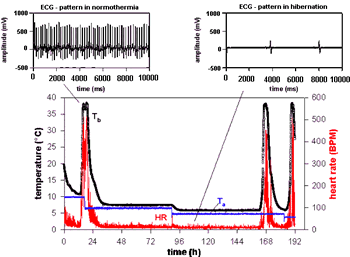Telemetry Research in Small Hibernators
Dormice are true hibernators with a body weight of 80-130g. They survive the cold and food restricted season with a hibernation period of up to seven months. These hibernators have the ability to reduce their metabolic rate for a fraction of their basal energy requirements and lower their body temperature close to ambient temperature. The researchers used a Data Sciences telemetry research system to study the hibernating small rodents for changes in body temperature, heart rate (HR) and electrocardiogram (ECG).

Dormice
The Data Sciences telemetry research system consisted of implantable transmitters (ETA-F20), a telemetry receiver (RPC-1), an ECG and an analog adapter (UA10). The researchers used an interface (Dacpad-71B, Data log) to convert the analog signals to digital for storing on a computer.The computer was controlled by custom-made software (QB45).
Prior to implantation the transmitters were calibrated in a temperature regulated water bath in a range of 0.5 to 41 degrees C. The dormice were anaesthetised with a mixture of Ketamine and Xylazine. An ETA-F20 biopotential transmitter was implanted into the abdominal cavity of each dormouse and fixed with the peritoneum. The flexible leads, extending from the housing, were sutured subcutaneously. The negative lead was positioned at the right shoulder, the positive at the lower left chest The peritoneum was sutured with resorbable catgut (1.5 metric), and the skin with sewing silk (1.5 metric). After a recovery period of 3 to 6 weeks with food and water ad libitum animals were prepared for long term studies.
The Data Sciences telemetry research system consisted of implantable transmitters (ETA-F20), a telemetry receiver (RPC-1), an ECG and an analog adapter (UA10). The researchers used an interface (Dacpad-71B, Data log) to convert the analog signals to digital for storing on a computer.The computer was controlled by custom-made software (QB45).Prior to implantation the transmitters were calibrated in a temperature regulated water bath in a range of 0.5 to 41 degrees C. The dormice were anaesthetised with a mixture of Ketamine and Xylazine. An ETA-F20 biopotential transmitter was implanted into the abdominal cavity of each dormouse and fixed with the peritoneum. The flexible leads, extending from the housing, were sutured subcutaneously. The negative lead was positioned at the right shoulder, the positive at the lower left chest The peritoneum was sutured with resorbable catgut (1.5 metric), and the skin with sewing silk (1.5 metric). After a recovery period of 3 to 6 weeks with food and water ad libitum animals were prepared for long term studies.

Continuous recording of T body, HR and T ambient of a hibernating dormouse. ECG-pattern (P to T-wave) is decelerated from normothermia to deep hibernation. Graphic used with permission.
The dormice were housed in a wire-meshed cage placed inside a climate chamber. Ambient temperatures varied between 0 and 30 degrees C. Through a revolving door the dormice had free access to a sleep and nesting box placed outside the cage. The transmitters sent signal pulses in intervals correlating with voltage output. Body temperature was calculated from voltage output following calibration of the transmitters, using the equation: T(degrees C)= sqrt(mVolt - Output-A)/B) . While one channel was used for calculating T body the other enabled calculation of HR from voltage peaks. Time intervals between these peaks correlated with HR. From scanning the signal input for 10 sec, several peaks were detected and a mean value was calculated. Ambient temperature (T ambient) was measured with a thermocouple placed inside the nesting box. All pmeters were monitored in 60 sec intervals and stored on the computer. An integrated snapshot mode enabled storage of raw mVolt-output values from heart rate channel in 1 msec intervals for analysis of ECG and PT-period, respectively.
When entering hibernation Tb decreased close to level of Ta and follows further temperature decreases. HR decreased after an initial peak of more than 500 BPM to a stable level varying between 7 and 20 BPM.
The authors applied the telemetric research system for measuring Tb, HR and ECG in unrestrained, freely moving dormice. Since animals had free access to a bigger cage it was possible to house them for months in the climate chamber being undisturbed except for weighing, feeding and refilling water. Because dormice spent most of the time of the diel cycle in their nesting box the authors were able to record physiological pameters in a long-term study in normothermic and hibernating dormice at different ambient temperatures.
Dept. of Biology, Philipps-University, Karl von Frisch Str., 35032 Marburg, Germany e-mail: elvert@mailer.uni-marburg.de Fax: +49-6421-288937
Telemetric observation of heart rate, ECG and body temperature in deep hibernation of edible dormice Elvert R. G. Heldmaier